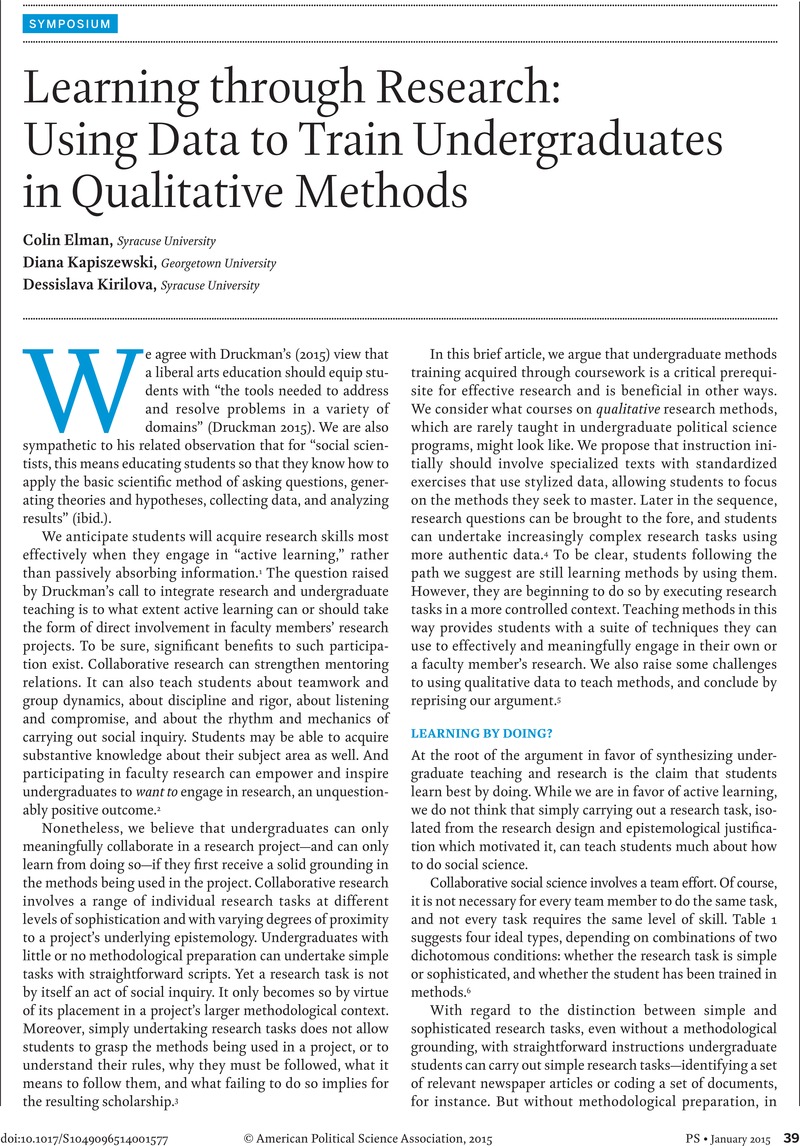Crossref Citations
This article has been cited by the following publications. This list is generated based on data provided by Crossref.
Davis, Shannon N.
Mahatmya, Duhita
Garner, Pamela W.
and
Jones, Rebecca M.
2015.
Mentoring Undergraduate Scholars: A Pathway to Interdisciplinary Research?.
Mentoring & Tutoring: Partnership in Learning,
Vol. 23,
Issue. 5,
p.
427.
Kenyon, Kristi Heather
2017.
Bringing the field into the classroom: Methods and experiential learning in the ‘Politics of Development’.
Politics,
Vol. 37,
Issue. 1,
p.
97.
Haaker, Maureen
and
Morgan-Brett, Bethany
2017.
Developing Research-Led Teaching: Two Cases of Practical Data Reuse in the Classroom.
Sage Open,
Vol. 7,
Issue. 2,
Kollars, Nina
and
Rosen, Amanda M.
2017.
Who’s Afraid of the Big Bad Methods? Methodological Games and Role Play.
Journal of Political Science Education,
Vol. 13,
Issue. 3,
p.
333.
Barr, Matthew
and
Jackson, Louise H.
2018.
Enhancing Delivery and Assessment: A Case Study in Module Redesign for Improved Transition Into Higher Education.
Journal of Political Science Education,
Vol. 14,
Issue. 3,
p.
390.
Schindler, Christoph
Veja, Cornelia
Hocker, Julian
Kminek, Helge
Meier, Michael
Bossu, Carina
and
Heck, Tamara
2020.
Collaborative open analysis in a qualitative research environment.
Education for Information,
Vol. 36,
Issue. 3,
p.
247.
Weinschenk, Aaron C.
2021.
Creating and Implementing an Undergraduate Research Lab in Political Science.
Journal of Political Science Education,
Vol. 17,
Issue. sup1,
p.
284.
Duncan, Natasha
and
Brown, Nadia
2021.
Learning-by-Doing: Teaching Qualitative Methods in DC.
Journal of Political Science Education,
Vol. 17,
Issue. sup1,
p.
341.
Dean, Laura
2021.
Pedagogical Approaches to Human Trafficking Through Applied Research Laboratories.
Anti-Trafficking Review,
p.
56.
Lam, Man Ho Adrian
and
Hung, Ho Ting (Bosco)
2024.
Comparative Analysis of the Undergraduate Political Science Research Methodology Course Syllabi among Hong Kong Universities.
Journal of Political Science Education,
Vol. 20,
Issue. 4,
p.
572.
Martinsson, Joel
and
Ricknell, Emma
2024.
From Laughter to Learning: Teaching Methods through Engaging Narrative Workshops.
Journal of Political Science Education,
p.
1.
Furlong, Darcy E.
Romero, Anna
Helström, Kirstin
Lester, Jessica Nina
and
Karcher, Sebastian
2024.
Teaching with shared data for learning qualitative data analysis: a multi-sited case study of instructor and student experiences.
International Journal of Research & Method in Education,
p.
1.
McSweeney, Patrick
2025.
Institutions of Engagement: Exploring Political Participation in University Yearbooks.
Journal of Political Science Education,
p.
1.



